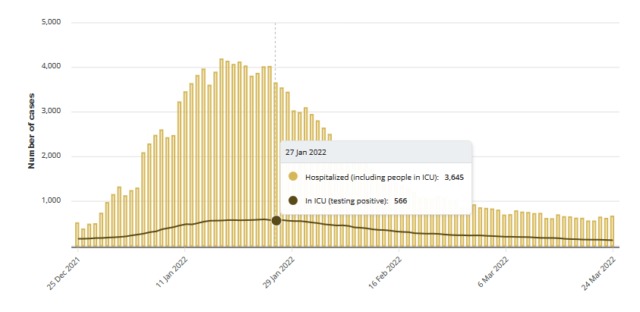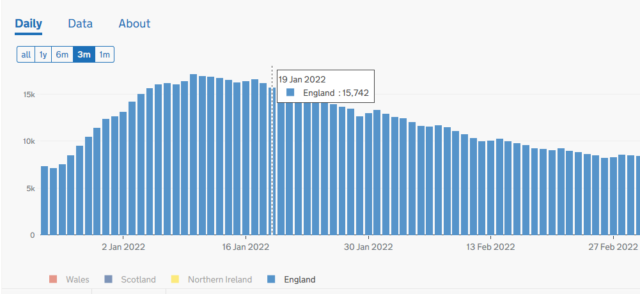It is popular to claim that the rolling back of covid restrictions in various jurisdictions is unrelated to protests against them, and that governments "follow the science".
We already know that the latter is tosh, since for example shutting down beaches is still a thing 2 years into the pandemic even though we know that "outdoor transmission contributes very little to overall infection rates". We know that covid restrictions are political, so it would not be surprising for their lifting to be tied to politics as well, i.e. protests.
Let us look at what seems to be the biggest protest against covid restrictions to date - the Freedom Convoy to Ottawa, Ontario, Canada, and covid restrictions in Ontario.
According to a timeline from the Toronto Star, the Freedom Convoy fundraiser started on January 14.
Just 2 days before, on January 12, the Ontario Liberals were still demanding mandatory covid vaccinations in schools
On January 20 Ontario announced a roadmap to reopening starting January 31, with capacity limits being lifted in indoor public settings by March 14 - but didn't say anything about vaccine passports.
On January 25, Premier Doug Ford said he couldn't see the mask mandate lifting anytime soon.
On January 27, GoFundMe released $1 million to the convoy and on January 28, it reached Ottawa.
Shortly thereafter, on February 14 - just 14 days after reopening had restarted, Ontario announced that measures were easing again on February 17. Then, a whole 2 weeks before capacity limits had been projected to be lifted in indoor public settings, not just had this been done on March 1, vaccine mandates too were done away with. All this despite Ford, just the previous month, claiming that there would be "21 days between each step to make sure we haven't moved too fast", and even that if they had to pause "between steps for a few extra days", they wouldn't "hesitate to do so", even if the classic phrase "out of an abundance of caution" has not been used (yet) this year.
And, less than 2 months after Doug Ford said he couldn't see the mask mandate lifting anytime soon, it too was gone on March 21.
Ontario had gone from (quasi-)lockdown and vaccine passports to not even a mask mandate in under 2 months - and ahead of schedule, generously violating prior proclamations about waiting for 21 days between steps.
Of course, ignoring all this, we are told that the restrictions were lifted because covid numbers were going in the right direction. But is this really true?
Recall that the roadmap to reopening was announced on January 20.
Yet, if you look at Ontario official hospitalisation numbers (since chief medical officer of health Dr. Kieran Moore called the hospitalisation rate "The most important metric that we're monitoring"), they didn't go down until January 27; even on the day of the announcement, both hospitalisations and ICU numbers were hovering around their peak.
Given the specified timeframe of 21 days between stages of reopening "to make sure we haven't moved too fast" (i.e. to make sure covid numbers were going in the right direction), even if you generously assume that they took a week to make decisions, that would imply that they would have needed to see falling hospitalisations for at least 14 days before deciding to lift more restrictions.
Even taking a more aggressive timeframe of 14 days of falling hospitalisations, the very earliest restrictions should have started to be lifted would have been February 10 - a whole 10 days before the actual reopening (and that assumes no lag between announcement and implementation).
So it's pretty clear that, at least in Ontario, the protests influenced reopening.
It is no coincidence that in England, when they announced they were lifting restrictions, covid hystericists cried bloody murder - since there had been no massive protests that they needed to pretend hadn't had any effect:
Boris Johnson announced on January 19 that Plan B measures would not be renewed, but by this time, covid hospitalisations in England had been gradually declining for 9 days.
And when Boris Johnson announced on February 21 that England was ending covid restrictions, he was condemned for being "reckless" - even as hospitalisations had been continuing to decline.
So if anything, England's relaxation of covid measures seems to have been more backed by the data than Ontario's.
So on the one hand, we can see in Ontario a relaxation of covid restrictions that was not supported by the numbers, whereas in England a similar removal restrictions was. Yet the latter was condemned while we are told that the former was justified by the "science" and was going to happen anyway. I wonder what could explain the difference in establishment reaction to both?
Addendum: One cope I've gotten in response to an earlier version of this essay is that Ontario was just sticking to its earlier announcement about reopening timelines. In October 2021, it had been announced that on March 28, the indoor mask mandate and vaccine passports were going to go away, so they were just sticking to the roadmap. Of course, this is a weak objection, since there was a one month (pseudo-)lockdown, which violated that very same roadmap.

